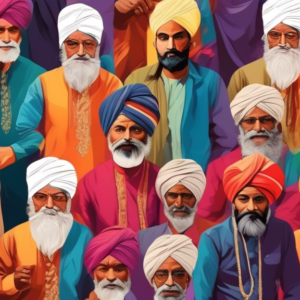The Cultural Significance of Turbans in India
The turban, a distinctive head covering, holds profound cultural and religious significance for many communities across India. It’s more than just an article of clothing; it symbolizes faith, honor, self-respect, courage, and spirituality. The styles, colors, and ways of tying turbans vary widely across different regions, religions, and social groups, reflecting India’s rich diversity.
Turbans in Sikhism
For Sikhs, the turban, known as the Dastar, is an integral part of their religious identity. It represents equality, spirituality, piety, self-respect, and courage. The turban is mandatory for Sikh men and is seen as a symbol of their commitment to Sikh values and principles. The practice of wearing turbans dates back to the early Sikh Gurus and is a visible symbol of their faith.
Turbans in Other Communities
Beyond Sikhism, turbans are worn by men from various other communities in India. In Rajasthan, the colorful turbans are a symbol of honor and social status. The style and color often indicate the wearer’s region, caste, or occupation. In many rural communities, turbans protect against the harsh sun and dust. They are also worn during special occasions and festivals as a mark of respect and tradition.
Addressing Bias in Generative AI
Despite the widespread use and cultural significance of turbans in India, there is a concerning lack of representation in the datasets used to train generative AI models. This leads to biased outputs where images of Indian men often exclude turbans or depict them inaccurately.
Impact of Bias
The underrepresentation of turbans in AI-generated images perpetuates harmful stereotypes and erases the visibility of a significant cultural practice. It reinforces the notion that turbans are not a normal part of Indian society, leading to feelings of exclusion and misrepresentation among communities that wear them.
Mitigating Bias
To address this bias, it is crucial to ensure that datasets used to train AI models are diverse and inclusive. This includes incorporating a wide range of images featuring men wearing turbans in various styles and contexts. Additionally, AI developers need to be aware of potential biases and actively work to mitigate them through techniques like data augmentation and bias detection algorithms.
Promoting Cultural Understanding
By accurately representing the prevalence of turbans among Indian men, generative AI can play a role in promoting cultural understanding and appreciation. It can help challenge stereotypes and showcase the diversity of Indian culture to a global audience.
Importance of Representation
Accurate representation in AI is not just about aesthetics; it has real-world implications. When AI systems fail to recognize and represent cultural symbols like turbans, it can lead to discrimination and exclusion in various domains, from facial recognition technology to image search results.
Building Inclusive AI
Building inclusive AI requires a concerted effort from researchers, developers, and data scientists. By working together to address biases and promote diversity, we can ensure that AI technology reflects the richness and complexity of human cultures, including the significant tradition of turban-wearing in India.
